HA3042 Taxation Law: FBT and CGT Analysis - Case Study Application
VerifiedAdded on 2023/03/31
|10
|2044
|409
Homework Assignment
AI Summary
This assignment solution delves into two key areas of taxation law: Fringe Benefit Tax (FBT) and Capital Gain Tax (CGT). The FBT analysis involves a case study of Lucinda receiving a car as a fringe benefit from her employer, Spice Co Pty Limited, with calculations performed using both the Statutory Formula Method and the Operating Cost Method to determine the most advantageous approach. The CGT analysis focuses on Daniel's various assets, including a house, painting, luxury yacht, and shares in BHP mining company, assessing the capital gains or losses associated with each asset and considering relevant discounts and exemptions. The solution also addresses the treatment of tax losses from previous years and the overall net capital gain for Daniel, concluding with a discussion on the inclusion of CGT in accessible income and the resulting tax liability. Desklib provides a platform to access this and many other solved assignments and past papers.
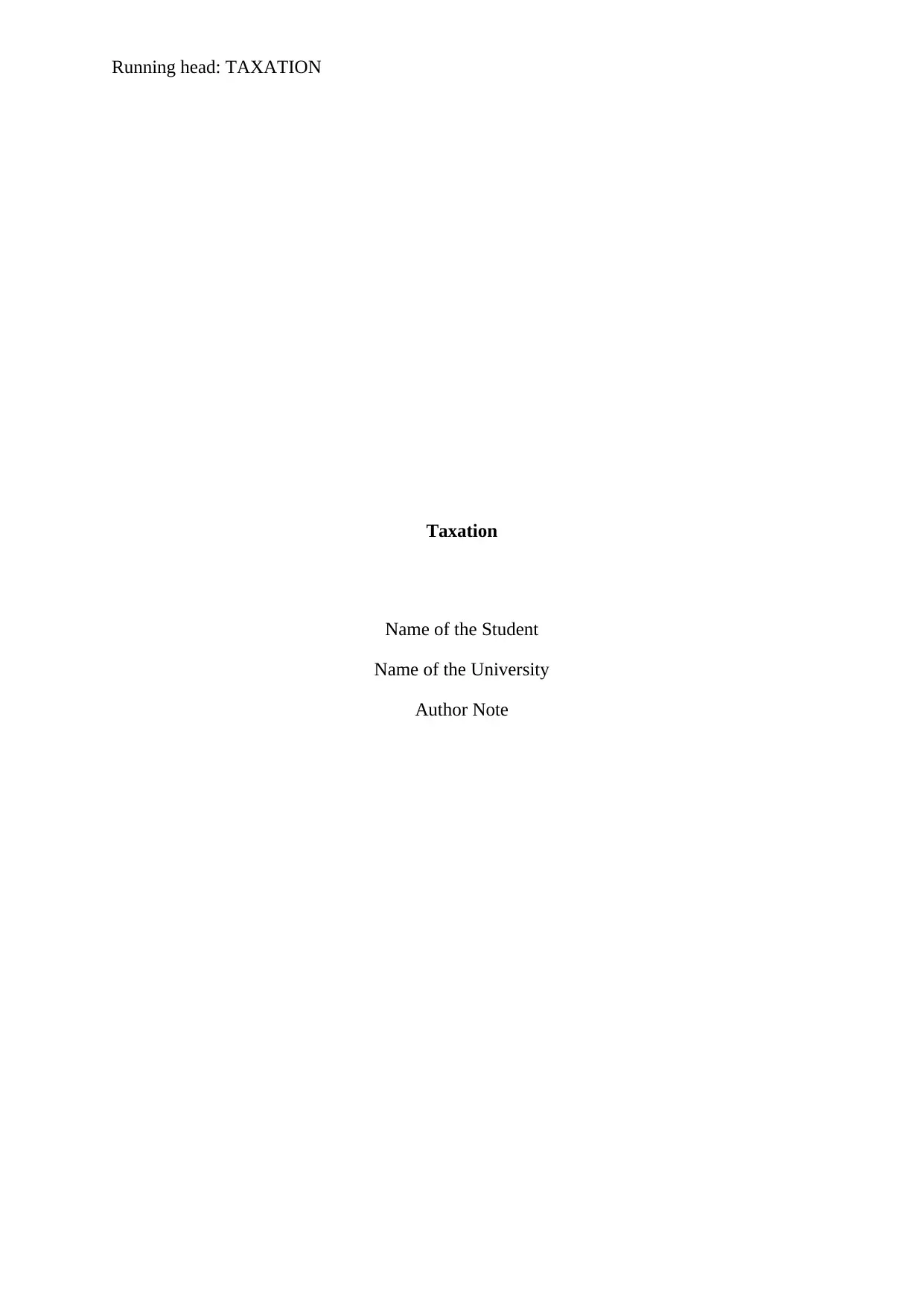
Running head: TAXATION
Taxation
Name of the Student
Name of the University
Author Note
Taxation
Name of the Student
Name of the University
Author Note
Paraphrase This Document
Need a fresh take? Get an instant paraphrase of this document with our AI Paraphraser
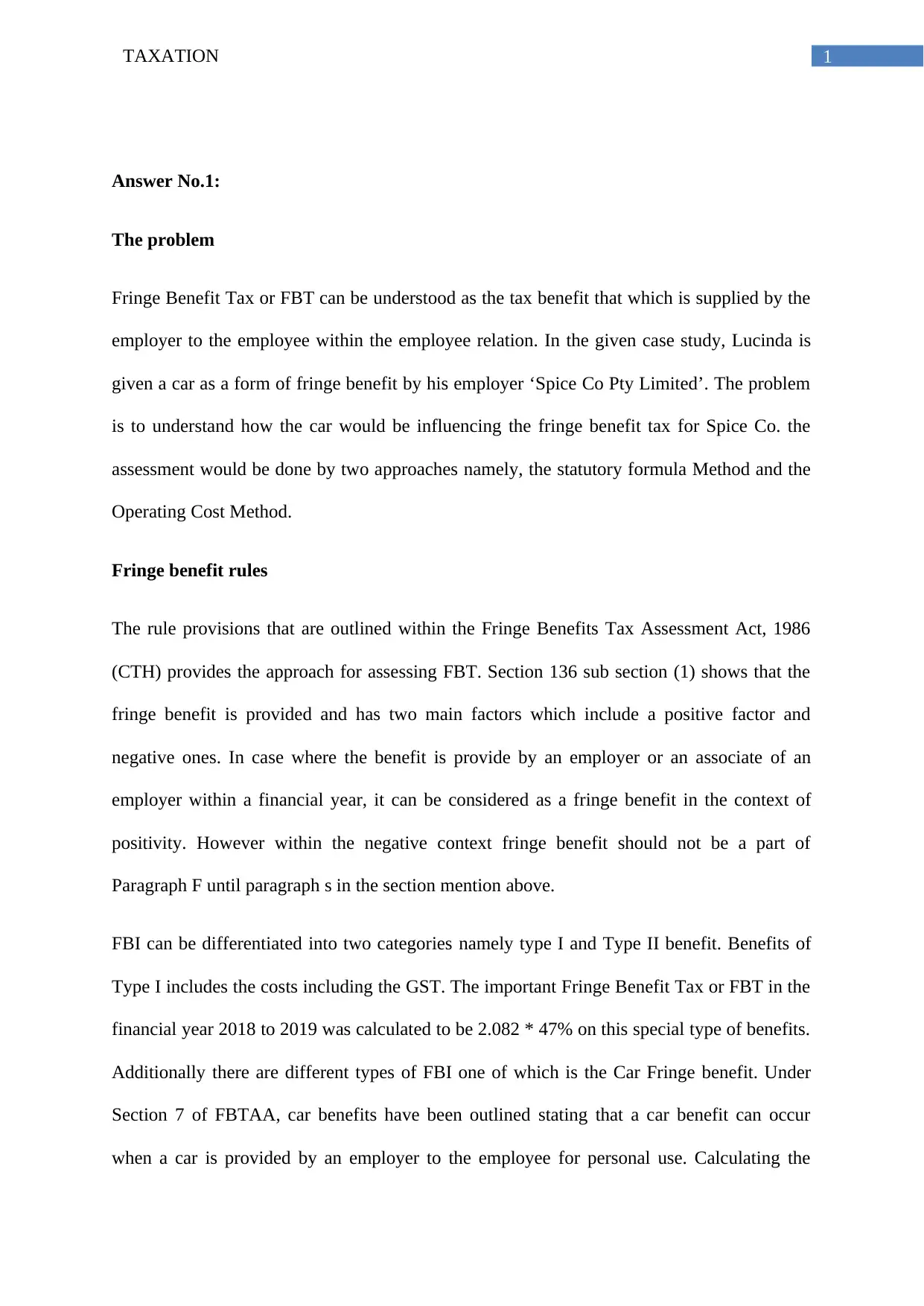
1TAXATION
Answer No.1:
The problem
Fringe Benefit Tax or FBT can be understood as the tax benefit that which is supplied by the
employer to the employee within the employee relation. In the given case study, Lucinda is
given a car as a form of fringe benefit by his employer ‘Spice Co Pty Limited’. The problem
is to understand how the car would be influencing the fringe benefit tax for Spice Co. the
assessment would be done by two approaches namely, the statutory formula Method and the
Operating Cost Method.
Fringe benefit rules
The rule provisions that are outlined within the Fringe Benefits Tax Assessment Act, 1986
(CTH) provides the approach for assessing FBT. Section 136 sub section (1) shows that the
fringe benefit is provided and has two main factors which include a positive factor and
negative ones. In case where the benefit is provide by an employer or an associate of an
employer within a financial year, it can be considered as a fringe benefit in the context of
positivity. However within the negative context fringe benefit should not be a part of
Paragraph F until paragraph s in the section mention above.
FBI can be differentiated into two categories namely type I and Type II benefit. Benefits of
Type I includes the costs including the GST. The important Fringe Benefit Tax or FBT in the
financial year 2018 to 2019 was calculated to be 2.082 * 47% on this special type of benefits.
Additionally there are different types of FBI one of which is the Car Fringe benefit. Under
Section 7 of FBTAA, car benefits have been outlined stating that a car benefit can occur
when a car is provided by an employer to the employee for personal use. Calculating the
Answer No.1:
The problem
Fringe Benefit Tax or FBT can be understood as the tax benefit that which is supplied by the
employer to the employee within the employee relation. In the given case study, Lucinda is
given a car as a form of fringe benefit by his employer ‘Spice Co Pty Limited’. The problem
is to understand how the car would be influencing the fringe benefit tax for Spice Co. the
assessment would be done by two approaches namely, the statutory formula Method and the
Operating Cost Method.
Fringe benefit rules
The rule provisions that are outlined within the Fringe Benefits Tax Assessment Act, 1986
(CTH) provides the approach for assessing FBT. Section 136 sub section (1) shows that the
fringe benefit is provided and has two main factors which include a positive factor and
negative ones. In case where the benefit is provide by an employer or an associate of an
employer within a financial year, it can be considered as a fringe benefit in the context of
positivity. However within the negative context fringe benefit should not be a part of
Paragraph F until paragraph s in the section mention above.
FBI can be differentiated into two categories namely type I and Type II benefit. Benefits of
Type I includes the costs including the GST. The important Fringe Benefit Tax or FBT in the
financial year 2018 to 2019 was calculated to be 2.082 * 47% on this special type of benefits.
Additionally there are different types of FBI one of which is the Car Fringe benefit. Under
Section 7 of FBTAA, car benefits have been outlined stating that a car benefit can occur
when a car is provided by an employer to the employee for personal use. Calculating the
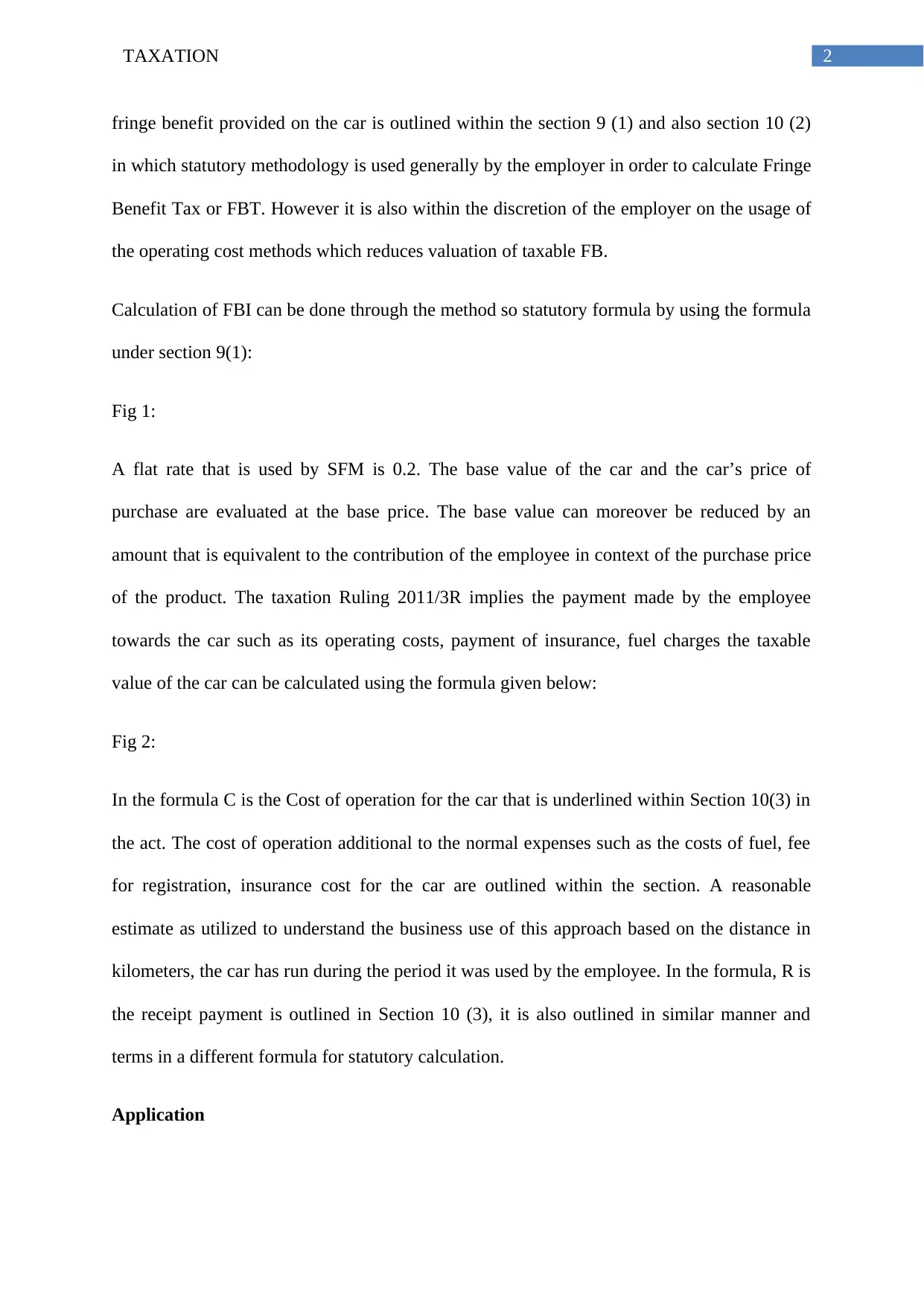
2TAXATION
fringe benefit provided on the car is outlined within the section 9 (1) and also section 10 (2)
in which statutory methodology is used generally by the employer in order to calculate Fringe
Benefit Tax or FBT. However it is also within the discretion of the employer on the usage of
the operating cost methods which reduces valuation of taxable FB.
Calculation of FBI can be done through the method so statutory formula by using the formula
under section 9(1):
Fig 1:
A flat rate that is used by SFM is 0.2. The base value of the car and the car’s price of
purchase are evaluated at the base price. The base value can moreover be reduced by an
amount that is equivalent to the contribution of the employee in context of the purchase price
of the product. The taxation Ruling 2011/3R implies the payment made by the employee
towards the car such as its operating costs, payment of insurance, fuel charges the taxable
value of the car can be calculated using the formula given below:
Fig 2:
In the formula C is the Cost of operation for the car that is underlined within Section 10(3) in
the act. The cost of operation additional to the normal expenses such as the costs of fuel, fee
for registration, insurance cost for the car are outlined within the section. A reasonable
estimate as utilized to understand the business use of this approach based on the distance in
kilometers, the car has run during the period it was used by the employee. In the formula, R is
the receipt payment is outlined in Section 10 (3), it is also outlined in similar manner and
terms in a different formula for statutory calculation.
Application
fringe benefit provided on the car is outlined within the section 9 (1) and also section 10 (2)
in which statutory methodology is used generally by the employer in order to calculate Fringe
Benefit Tax or FBT. However it is also within the discretion of the employer on the usage of
the operating cost methods which reduces valuation of taxable FB.
Calculation of FBI can be done through the method so statutory formula by using the formula
under section 9(1):
Fig 1:
A flat rate that is used by SFM is 0.2. The base value of the car and the car’s price of
purchase are evaluated at the base price. The base value can moreover be reduced by an
amount that is equivalent to the contribution of the employee in context of the purchase price
of the product. The taxation Ruling 2011/3R implies the payment made by the employee
towards the car such as its operating costs, payment of insurance, fuel charges the taxable
value of the car can be calculated using the formula given below:
Fig 2:
In the formula C is the Cost of operation for the car that is underlined within Section 10(3) in
the act. The cost of operation additional to the normal expenses such as the costs of fuel, fee
for registration, insurance cost for the car are outlined within the section. A reasonable
estimate as utilized to understand the business use of this approach based on the distance in
kilometers, the car has run during the period it was used by the employee. In the formula, R is
the receipt payment is outlined in Section 10 (3), it is also outlined in similar manner and
terms in a different formula for statutory calculation.
Application
⊘ This is a preview!⊘
Do you want full access?
Subscribe today to unlock all pages.

Trusted by 1+ million students worldwide
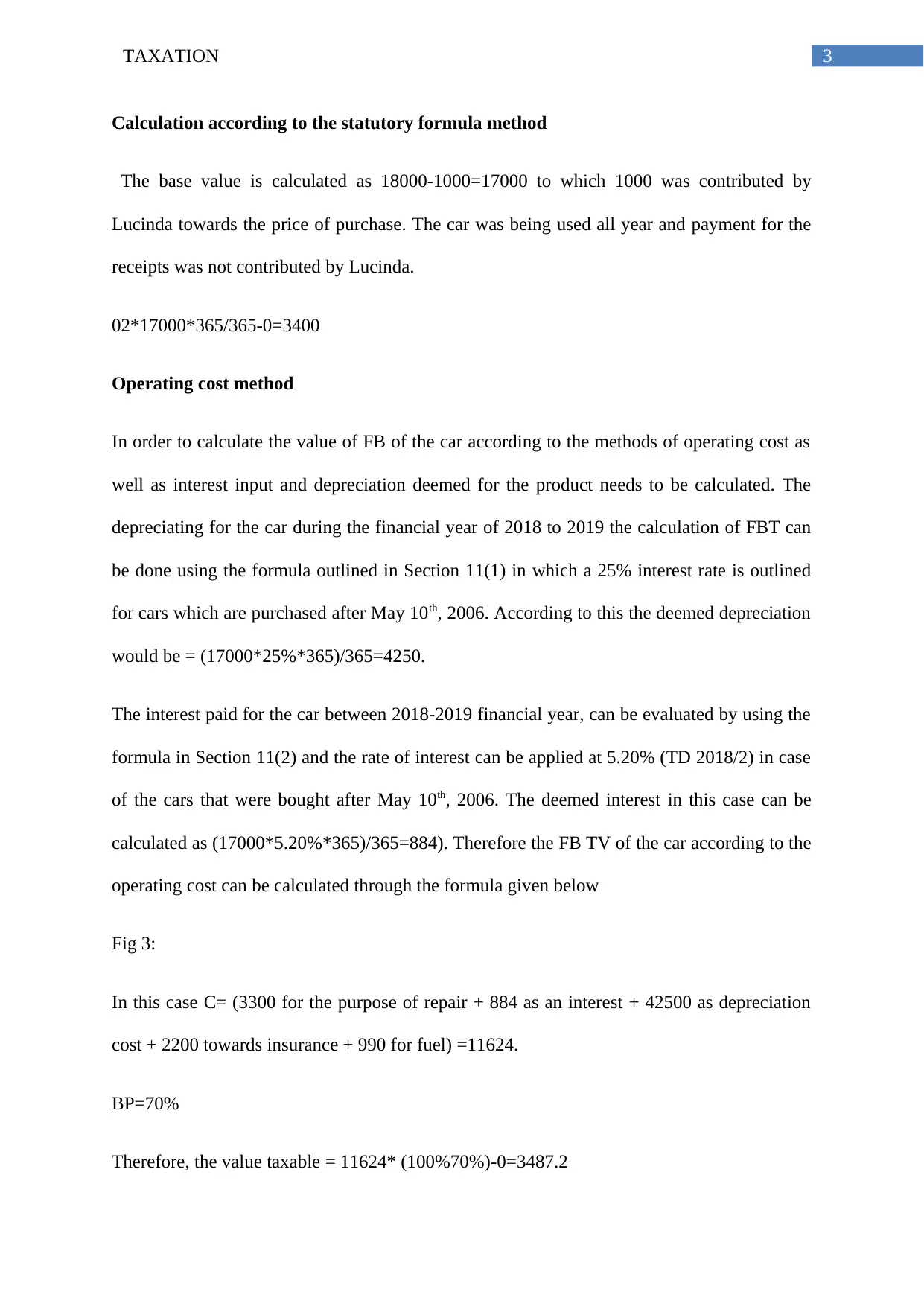
3TAXATION
Calculation according to the statutory formula method
The base value is calculated as 18000-1000=17000 to which 1000 was contributed by
Lucinda towards the price of purchase. The car was being used all year and payment for the
receipts was not contributed by Lucinda.
02*17000*365/365-0=3400
Operating cost method
In order to calculate the value of FB of the car according to the methods of operating cost as
well as interest input and depreciation deemed for the product needs to be calculated. The
depreciating for the car during the financial year of 2018 to 2019 the calculation of FBT can
be done using the formula outlined in Section 11(1) in which a 25% interest rate is outlined
for cars which are purchased after May 10th, 2006. According to this the deemed depreciation
would be = (17000*25%*365)/365=4250.
The interest paid for the car between 2018-2019 financial year, can be evaluated by using the
formula in Section 11(2) and the rate of interest can be applied at 5.20% (TD 2018/2) in case
of the cars that were bought after May 10th, 2006. The deemed interest in this case can be
calculated as (17000*5.20%*365)/365=884). Therefore the FB TV of the car according to the
operating cost can be calculated through the formula given below
Fig 3:
In this case C= (3300 for the purpose of repair + 884 as an interest + 42500 as depreciation
cost + 2200 towards insurance + 990 for fuel) =11624.
BP=70%
Therefore, the value taxable = 11624* (100%70%)-0=3487.2
Calculation according to the statutory formula method
The base value is calculated as 18000-1000=17000 to which 1000 was contributed by
Lucinda towards the price of purchase. The car was being used all year and payment for the
receipts was not contributed by Lucinda.
02*17000*365/365-0=3400
Operating cost method
In order to calculate the value of FB of the car according to the methods of operating cost as
well as interest input and depreciation deemed for the product needs to be calculated. The
depreciating for the car during the financial year of 2018 to 2019 the calculation of FBT can
be done using the formula outlined in Section 11(1) in which a 25% interest rate is outlined
for cars which are purchased after May 10th, 2006. According to this the deemed depreciation
would be = (17000*25%*365)/365=4250.
The interest paid for the car between 2018-2019 financial year, can be evaluated by using the
formula in Section 11(2) and the rate of interest can be applied at 5.20% (TD 2018/2) in case
of the cars that were bought after May 10th, 2006. The deemed interest in this case can be
calculated as (17000*5.20%*365)/365=884). Therefore the FB TV of the car according to the
operating cost can be calculated through the formula given below
Fig 3:
In this case C= (3300 for the purpose of repair + 884 as an interest + 42500 as depreciation
cost + 2200 towards insurance + 990 for fuel) =11624.
BP=70%
Therefore, the value taxable = 11624* (100%70%)-0=3487.2
Paraphrase This Document
Need a fresh take? Get an instant paraphrase of this document with our AI Paraphraser
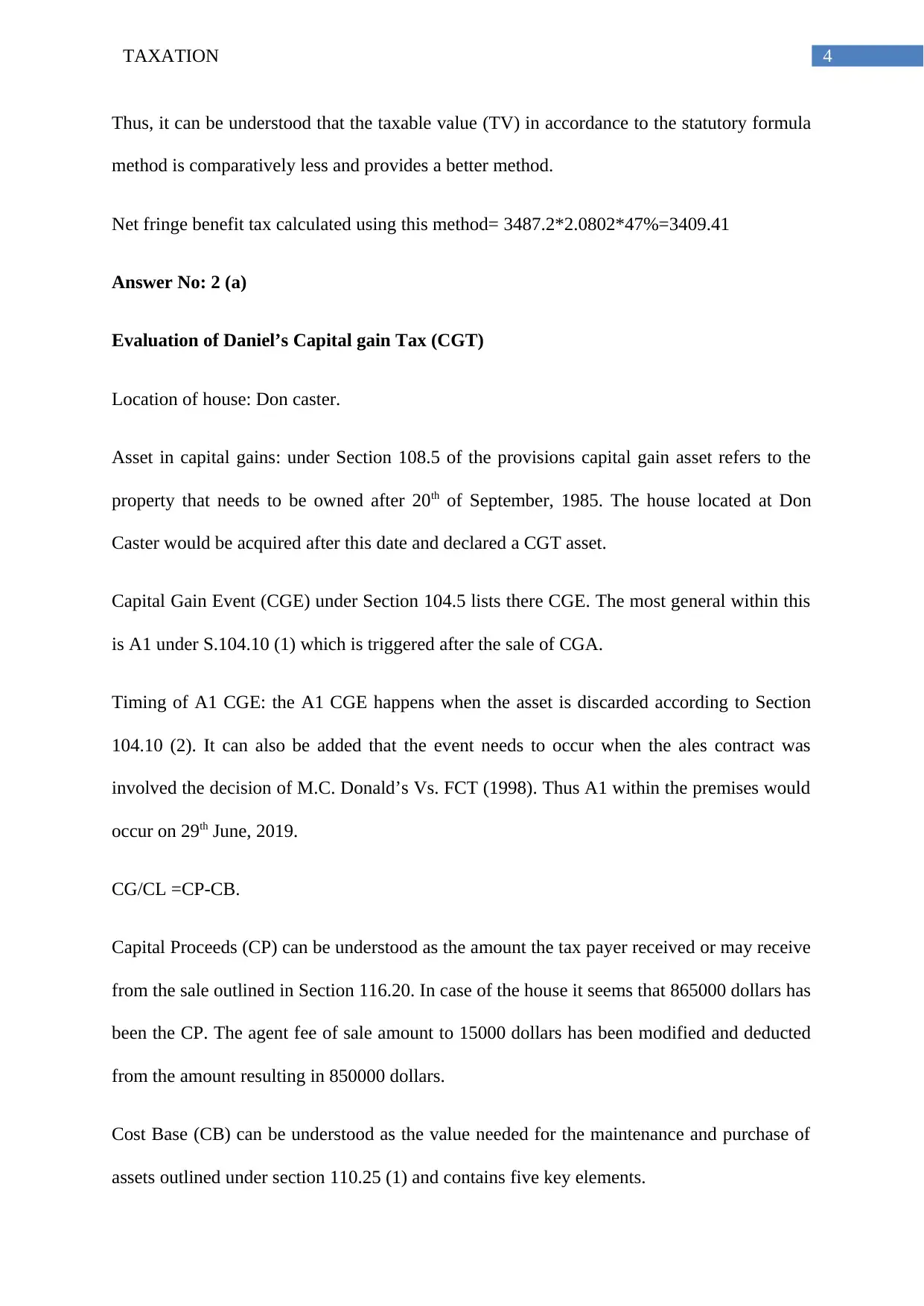
4TAXATION
Thus, it can be understood that the taxable value (TV) in accordance to the statutory formula
method is comparatively less and provides a better method.
Net fringe benefit tax calculated using this method= 3487.2*2.0802*47%=3409.41
Answer No: 2 (a)
Evaluation of Daniel’s Capital gain Tax (CGT)
Location of house: Don caster.
Asset in capital gains: under Section 108.5 of the provisions capital gain asset refers to the
property that needs to be owned after 20th of September, 1985. The house located at Don
Caster would be acquired after this date and declared a CGT asset.
Capital Gain Event (CGE) under Section 104.5 lists there CGE. The most general within this
is A1 under S.104.10 (1) which is triggered after the sale of CGA.
Timing of A1 CGE: the A1 CGE happens when the asset is discarded according to Section
104.10 (2). It can also be added that the event needs to occur when the ales contract was
involved the decision of M.C. Donald’s Vs. FCT (1998). Thus A1 within the premises would
occur on 29th June, 2019.
CG/CL =CP-CB.
Capital Proceeds (CP) can be understood as the amount the tax payer received or may receive
from the sale outlined in Section 116.20. In case of the house it seems that 865000 dollars has
been the CP. The agent fee of sale amount to 15000 dollars has been modified and deducted
from the amount resulting in 850000 dollars.
Cost Base (CB) can be understood as the value needed for the maintenance and purchase of
assets outlined under section 110.25 (1) and contains five key elements.
Thus, it can be understood that the taxable value (TV) in accordance to the statutory formula
method is comparatively less and provides a better method.
Net fringe benefit tax calculated using this method= 3487.2*2.0802*47%=3409.41
Answer No: 2 (a)
Evaluation of Daniel’s Capital gain Tax (CGT)
Location of house: Don caster.
Asset in capital gains: under Section 108.5 of the provisions capital gain asset refers to the
property that needs to be owned after 20th of September, 1985. The house located at Don
Caster would be acquired after this date and declared a CGT asset.
Capital Gain Event (CGE) under Section 104.5 lists there CGE. The most general within this
is A1 under S.104.10 (1) which is triggered after the sale of CGA.
Timing of A1 CGE: the A1 CGE happens when the asset is discarded according to Section
104.10 (2). It can also be added that the event needs to occur when the ales contract was
involved the decision of M.C. Donald’s Vs. FCT (1998). Thus A1 within the premises would
occur on 29th June, 2019.
CG/CL =CP-CB.
Capital Proceeds (CP) can be understood as the amount the tax payer received or may receive
from the sale outlined in Section 116.20. In case of the house it seems that 865000 dollars has
been the CP. The agent fee of sale amount to 15000 dollars has been modified and deducted
from the amount resulting in 850000 dollars.
Cost Base (CB) can be understood as the value needed for the maintenance and purchase of
assets outlined under section 110.25 (1) and contains five key elements.
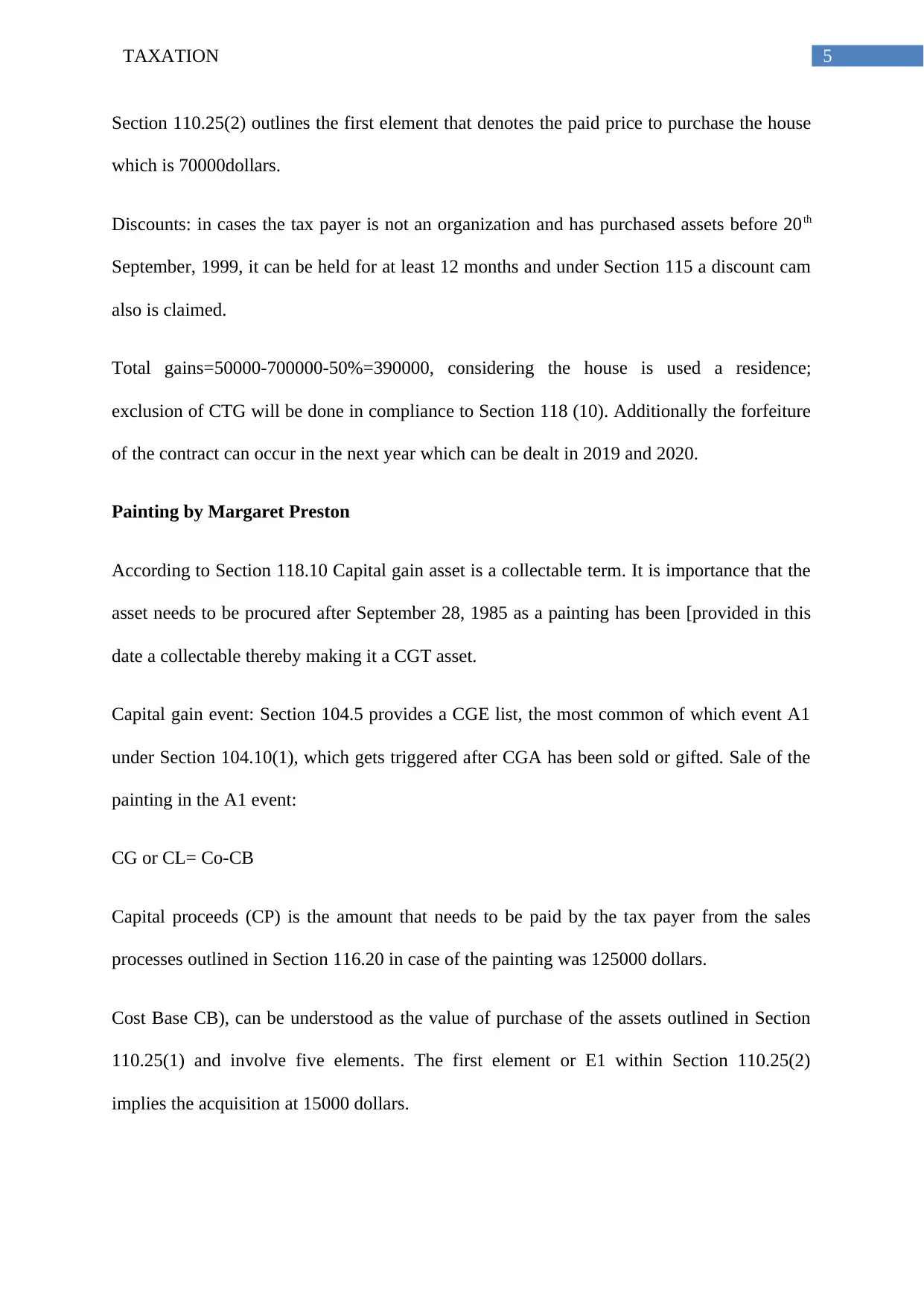
5TAXATION
Section 110.25(2) outlines the first element that denotes the paid price to purchase the house
which is 70000dollars.
Discounts: in cases the tax payer is not an organization and has purchased assets before 20th
September, 1999, it can be held for at least 12 months and under Section 115 a discount cam
also is claimed.
Total gains=50000-700000-50%=390000, considering the house is used a residence;
exclusion of CTG will be done in compliance to Section 118 (10). Additionally the forfeiture
of the contract can occur in the next year which can be dealt in 2019 and 2020.
Painting by Margaret Preston
According to Section 118.10 Capital gain asset is a collectable term. It is importance that the
asset needs to be procured after September 28, 1985 as a painting has been [provided in this
date a collectable thereby making it a CGT asset.
Capital gain event: Section 104.5 provides a CGE list, the most common of which event A1
under Section 104.10(1), which gets triggered after CGA has been sold or gifted. Sale of the
painting in the A1 event:
CG or CL= Co-CB
Capital proceeds (CP) is the amount that needs to be paid by the tax payer from the sales
processes outlined in Section 116.20 in case of the painting was 125000 dollars.
Cost Base CB), can be understood as the value of purchase of the assets outlined in Section
110.25(1) and involve five elements. The first element or E1 within Section 110.25(2)
implies the acquisition at 15000 dollars.
Section 110.25(2) outlines the first element that denotes the paid price to purchase the house
which is 70000dollars.
Discounts: in cases the tax payer is not an organization and has purchased assets before 20th
September, 1999, it can be held for at least 12 months and under Section 115 a discount cam
also is claimed.
Total gains=50000-700000-50%=390000, considering the house is used a residence;
exclusion of CTG will be done in compliance to Section 118 (10). Additionally the forfeiture
of the contract can occur in the next year which can be dealt in 2019 and 2020.
Painting by Margaret Preston
According to Section 118.10 Capital gain asset is a collectable term. It is importance that the
asset needs to be procured after September 28, 1985 as a painting has been [provided in this
date a collectable thereby making it a CGT asset.
Capital gain event: Section 104.5 provides a CGE list, the most common of which event A1
under Section 104.10(1), which gets triggered after CGA has been sold or gifted. Sale of the
painting in the A1 event:
CG or CL= Co-CB
Capital proceeds (CP) is the amount that needs to be paid by the tax payer from the sales
processes outlined in Section 116.20 in case of the painting was 125000 dollars.
Cost Base CB), can be understood as the value of purchase of the assets outlined in Section
110.25(1) and involve five elements. The first element or E1 within Section 110.25(2)
implies the acquisition at 15000 dollars.
⊘ This is a preview!⊘
Do you want full access?
Subscribe today to unlock all pages.

Trusted by 1+ million students worldwide
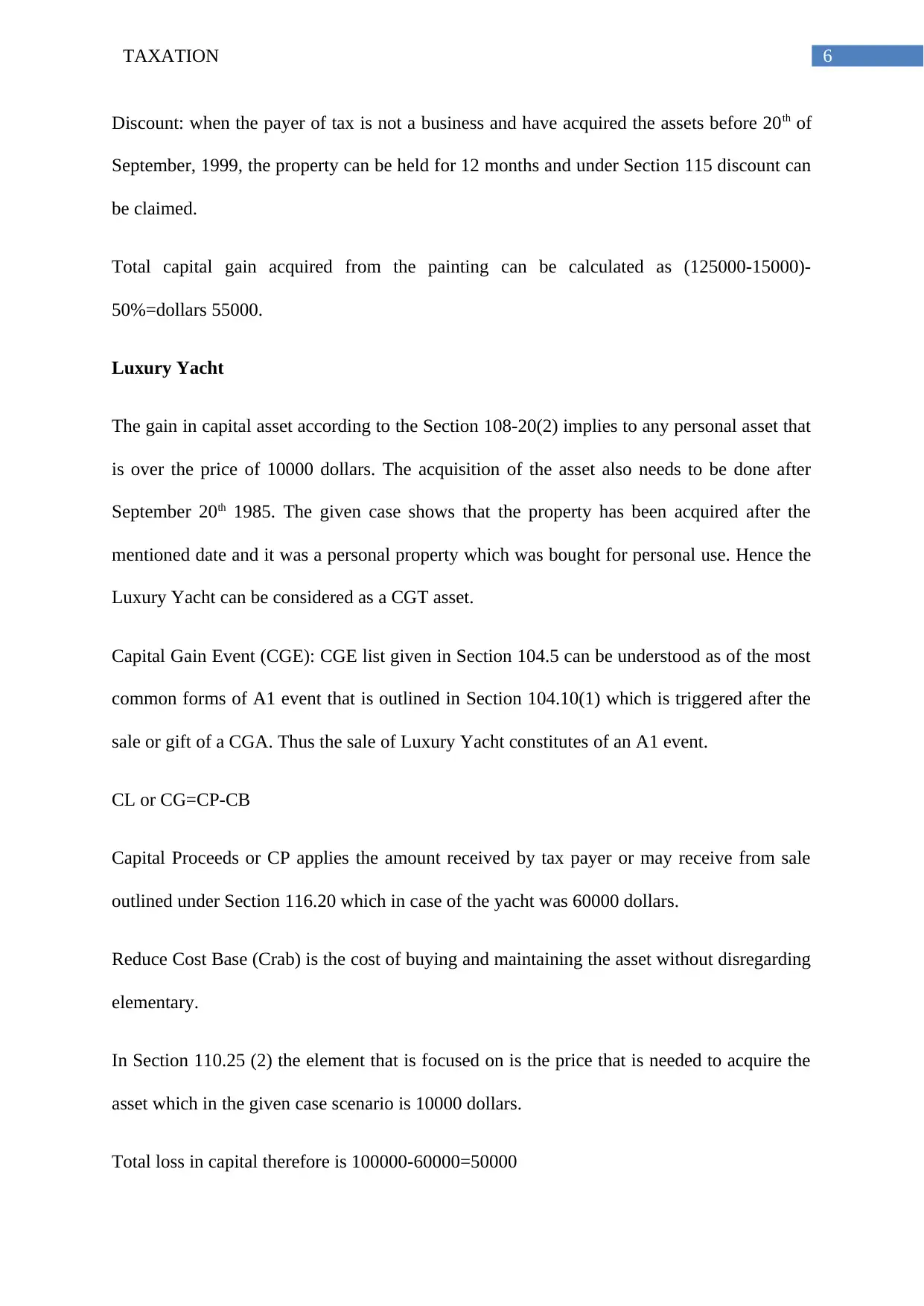
6TAXATION
Discount: when the payer of tax is not a business and have acquired the assets before 20th of
September, 1999, the property can be held for 12 months and under Section 115 discount can
be claimed.
Total capital gain acquired from the painting can be calculated as (125000-15000)-
50%=dollars 55000.
Luxury Yacht
The gain in capital asset according to the Section 108-20(2) implies to any personal asset that
is over the price of 10000 dollars. The acquisition of the asset also needs to be done after
September 20th 1985. The given case shows that the property has been acquired after the
mentioned date and it was a personal property which was bought for personal use. Hence the
Luxury Yacht can be considered as a CGT asset.
Capital Gain Event (CGE): CGE list given in Section 104.5 can be understood as of the most
common forms of A1 event that is outlined in Section 104.10(1) which is triggered after the
sale or gift of a CGA. Thus the sale of Luxury Yacht constitutes of an A1 event.
CL or CG=CP-CB
Capital Proceeds or CP applies the amount received by tax payer or may receive from sale
outlined under Section 116.20 which in case of the yacht was 60000 dollars.
Reduce Cost Base (Crab) is the cost of buying and maintaining the asset without disregarding
elementary.
In Section 110.25 (2) the element that is focused on is the price that is needed to acquire the
asset which in the given case scenario is 10000 dollars.
Total loss in capital therefore is 100000-60000=50000
Discount: when the payer of tax is not a business and have acquired the assets before 20th of
September, 1999, the property can be held for 12 months and under Section 115 discount can
be claimed.
Total capital gain acquired from the painting can be calculated as (125000-15000)-
50%=dollars 55000.
Luxury Yacht
The gain in capital asset according to the Section 108-20(2) implies to any personal asset that
is over the price of 10000 dollars. The acquisition of the asset also needs to be done after
September 20th 1985. The given case shows that the property has been acquired after the
mentioned date and it was a personal property which was bought for personal use. Hence the
Luxury Yacht can be considered as a CGT asset.
Capital Gain Event (CGE): CGE list given in Section 104.5 can be understood as of the most
common forms of A1 event that is outlined in Section 104.10(1) which is triggered after the
sale or gift of a CGA. Thus the sale of Luxury Yacht constitutes of an A1 event.
CL or CG=CP-CB
Capital Proceeds or CP applies the amount received by tax payer or may receive from sale
outlined under Section 116.20 which in case of the yacht was 60000 dollars.
Reduce Cost Base (Crab) is the cost of buying and maintaining the asset without disregarding
elementary.
In Section 110.25 (2) the element that is focused on is the price that is needed to acquire the
asset which in the given case scenario is 10000 dollars.
Total loss in capital therefore is 100000-60000=50000
Paraphrase This Document
Need a fresh take? Get an instant paraphrase of this document with our AI Paraphraser
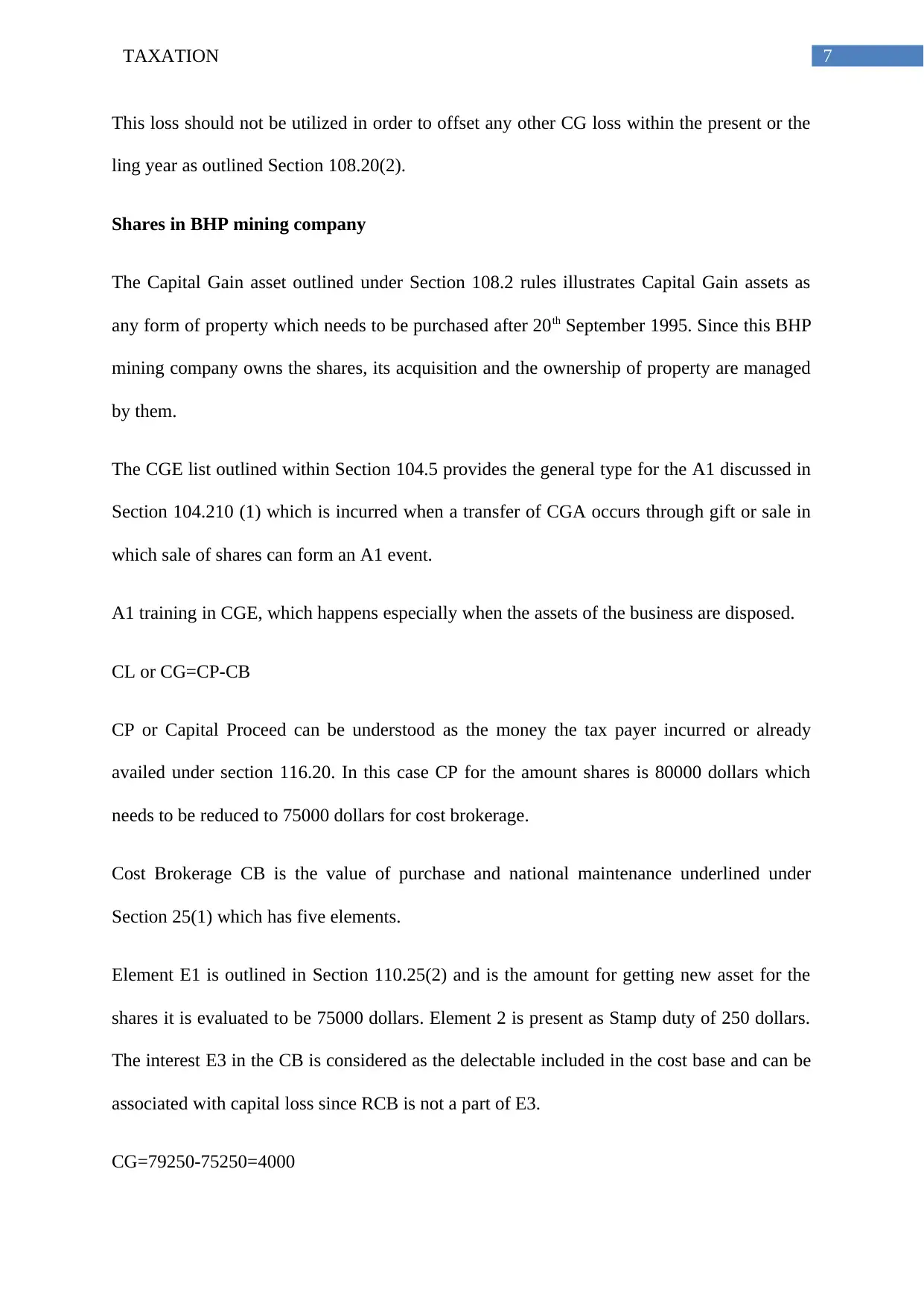
7TAXATION
This loss should not be utilized in order to offset any other CG loss within the present or the
ling year as outlined Section 108.20(2).
Shares in BHP mining company
The Capital Gain asset outlined under Section 108.2 rules illustrates Capital Gain assets as
any form of property which needs to be purchased after 20th September 1995. Since this BHP
mining company owns the shares, its acquisition and the ownership of property are managed
by them.
The CGE list outlined within Section 104.5 provides the general type for the A1 discussed in
Section 104.210 (1) which is incurred when a transfer of CGA occurs through gift or sale in
which sale of shares can form an A1 event.
A1 training in CGE, which happens especially when the assets of the business are disposed.
CL or CG=CP-CB
CP or Capital Proceed can be understood as the money the tax payer incurred or already
availed under section 116.20. In this case CP for the amount shares is 80000 dollars which
needs to be reduced to 75000 dollars for cost brokerage.
Cost Brokerage CB is the value of purchase and national maintenance underlined under
Section 25(1) which has five elements.
Element E1 is outlined in Section 110.25(2) and is the amount for getting new asset for the
shares it is evaluated to be 75000 dollars. Element 2 is present as Stamp duty of 250 dollars.
The interest E3 in the CB is considered as the delectable included in the cost base and can be
associated with capital loss since RCB is not a part of E3.
CG=79250-75250=4000
This loss should not be utilized in order to offset any other CG loss within the present or the
ling year as outlined Section 108.20(2).
Shares in BHP mining company
The Capital Gain asset outlined under Section 108.2 rules illustrates Capital Gain assets as
any form of property which needs to be purchased after 20th September 1995. Since this BHP
mining company owns the shares, its acquisition and the ownership of property are managed
by them.
The CGE list outlined within Section 104.5 provides the general type for the A1 discussed in
Section 104.210 (1) which is incurred when a transfer of CGA occurs through gift or sale in
which sale of shares can form an A1 event.
A1 training in CGE, which happens especially when the assets of the business are disposed.
CL or CG=CP-CB
CP or Capital Proceed can be understood as the money the tax payer incurred or already
availed under section 116.20. In this case CP for the amount shares is 80000 dollars which
needs to be reduced to 75000 dollars for cost brokerage.
Cost Brokerage CB is the value of purchase and national maintenance underlined under
Section 25(1) which has five elements.
Element E1 is outlined in Section 110.25(2) and is the amount for getting new asset for the
shares it is evaluated to be 75000 dollars. Element 2 is present as Stamp duty of 250 dollars.
The interest E3 in the CB is considered as the delectable included in the cost base and can be
associated with capital loss since RCB is not a part of E3.
CG=79250-75250=4000
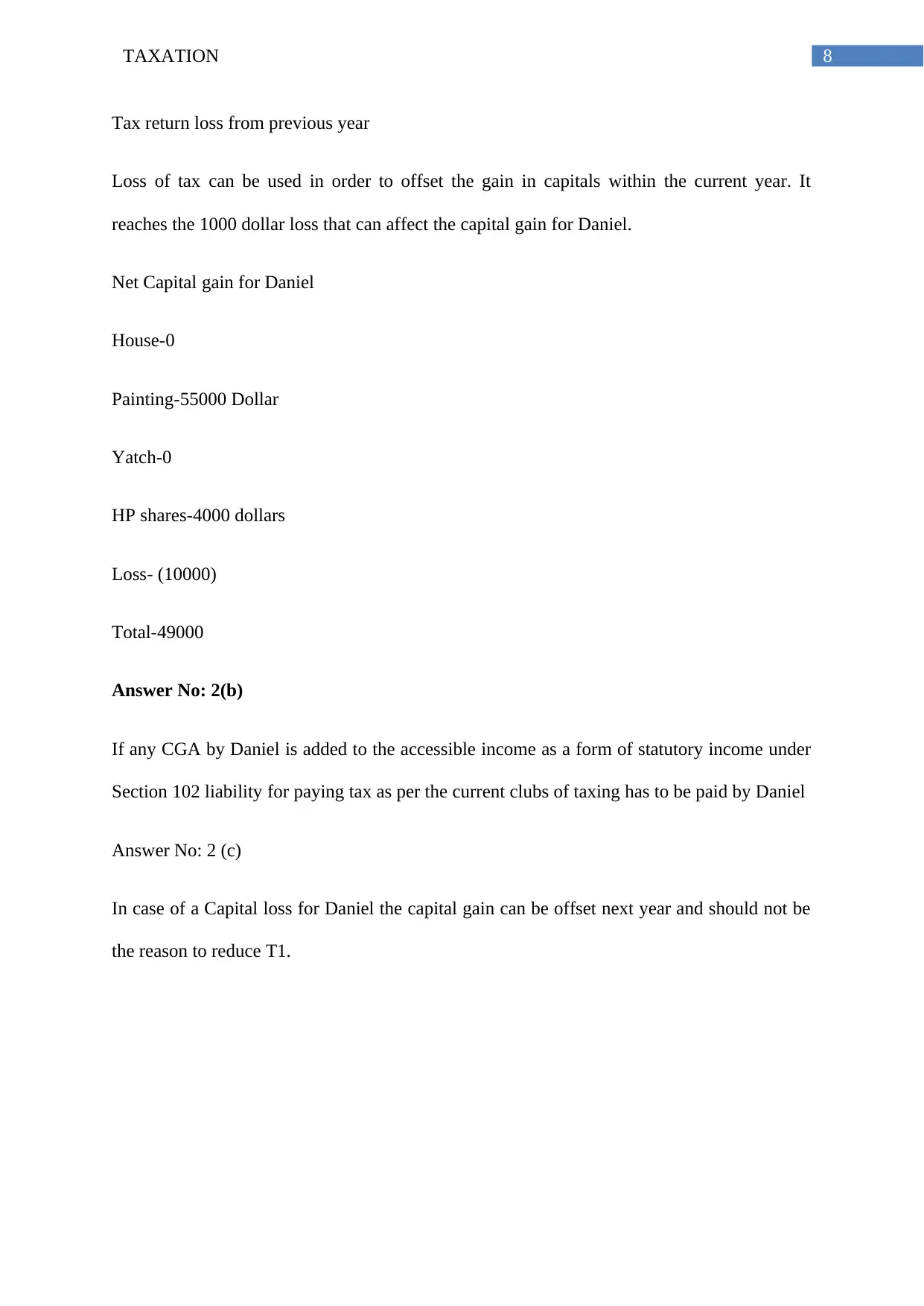
8TAXATION
Tax return loss from previous year
Loss of tax can be used in order to offset the gain in capitals within the current year. It
reaches the 1000 dollar loss that can affect the capital gain for Daniel.
Net Capital gain for Daniel
House-0
Painting-55000 Dollar
Yatch-0
HP shares-4000 dollars
Loss- (10000)
Total-49000
Answer No: 2(b)
If any CGA by Daniel is added to the accessible income as a form of statutory income under
Section 102 liability for paying tax as per the current clubs of taxing has to be paid by Daniel
Answer No: 2 (c)
In case of a Capital loss for Daniel the capital gain can be offset next year and should not be
the reason to reduce T1.
Tax return loss from previous year
Loss of tax can be used in order to offset the gain in capitals within the current year. It
reaches the 1000 dollar loss that can affect the capital gain for Daniel.
Net Capital gain for Daniel
House-0
Painting-55000 Dollar
Yatch-0
HP shares-4000 dollars
Loss- (10000)
Total-49000
Answer No: 2(b)
If any CGA by Daniel is added to the accessible income as a form of statutory income under
Section 102 liability for paying tax as per the current clubs of taxing has to be paid by Daniel
Answer No: 2 (c)
In case of a Capital loss for Daniel the capital gain can be offset next year and should not be
the reason to reduce T1.
⊘ This is a preview!⊘
Do you want full access?
Subscribe today to unlock all pages.

Trusted by 1+ million students worldwide
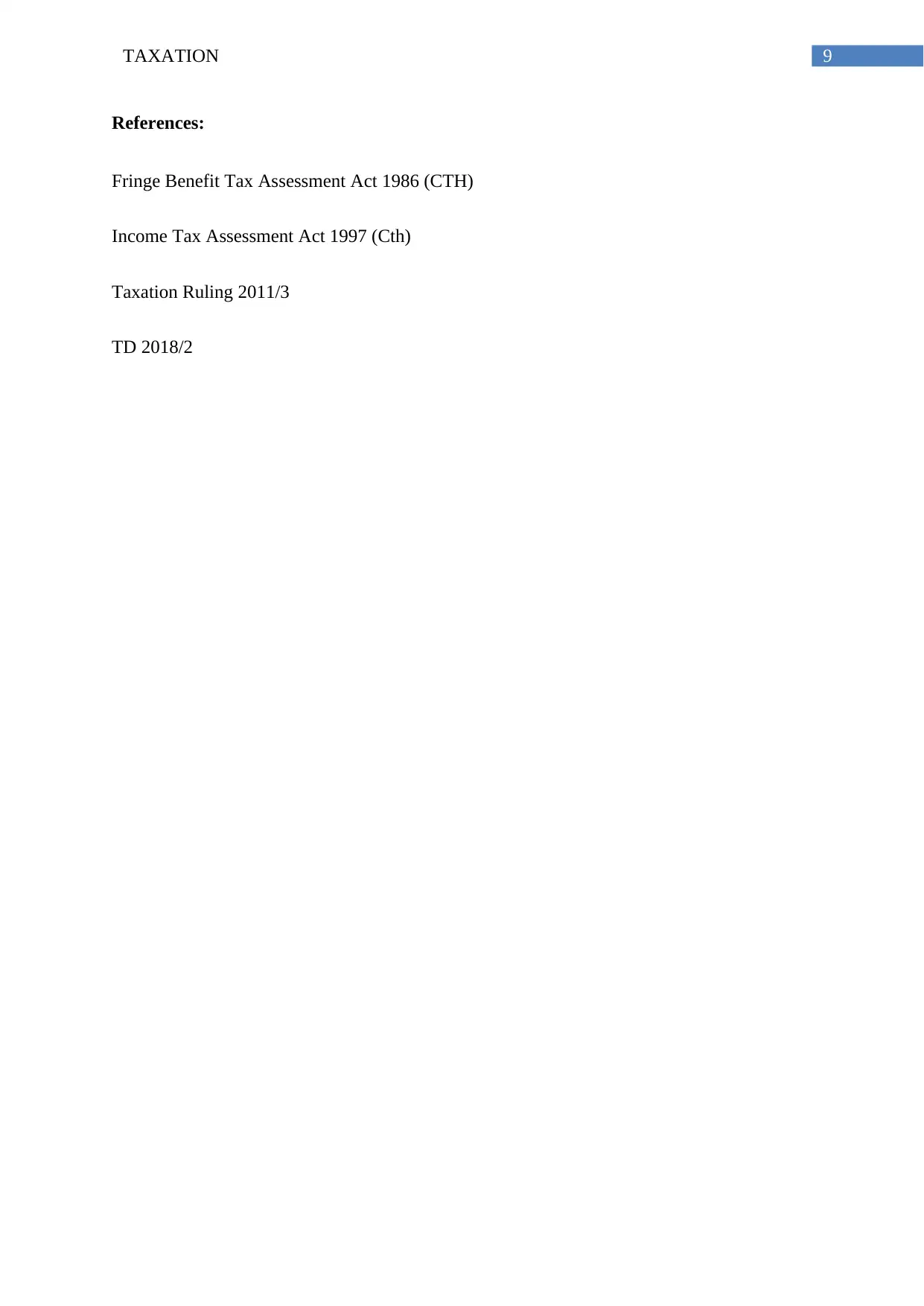
9TAXATION
References:
Fringe Benefit Tax Assessment Act 1986 (CTH)
Income Tax Assessment Act 1997 (Cth)
Taxation Ruling 2011/3
TD 2018/2
References:
Fringe Benefit Tax Assessment Act 1986 (CTH)
Income Tax Assessment Act 1997 (Cth)
Taxation Ruling 2011/3
TD 2018/2
1 out of 10
Related Documents
Your All-in-One AI-Powered Toolkit for Academic Success.
+13062052269
info@desklib.com
Available 24*7 on WhatsApp / Email
![[object Object]](/_next/static/media/star-bottom.7253800d.svg)
Unlock your academic potential
Copyright © 2020–2025 A2Z Services. All Rights Reserved. Developed and managed by ZUCOL.





